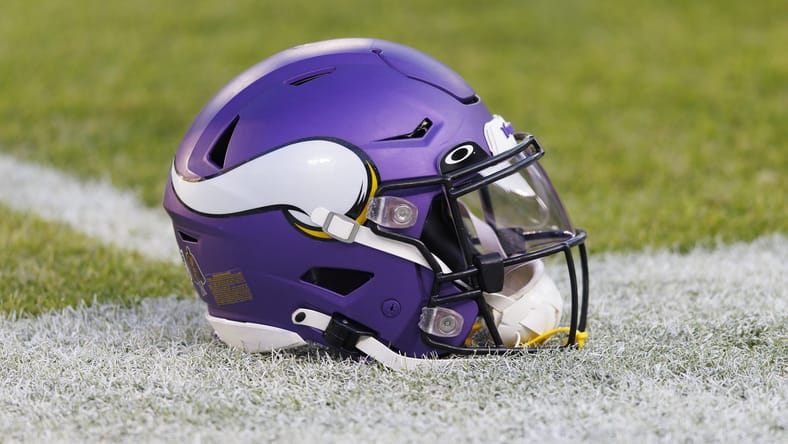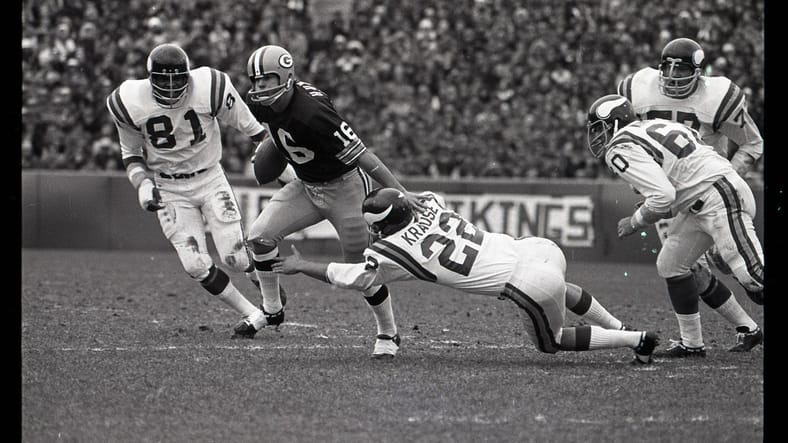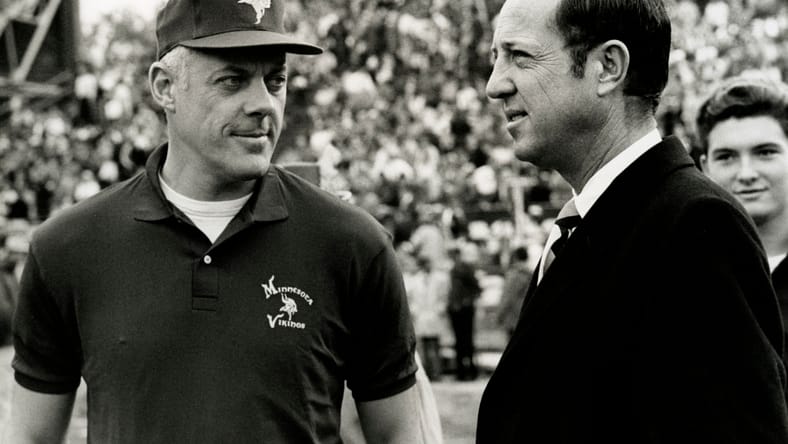The Hall Of Fame Series: Jim Finks

Class Of 1995
For as much emphasis as NFL fans put on game day, it’s easy to forget that those 17 days are the culmination of a week of preparation and rosters built behind the scenes over a collection of years. When teams lose, the blame usually falls on the shoulders of the head coach. But a team can’t win if there isn’t any talent. While it’s up to the coach to bring out the full potential of the talent he is given, it’s the responsibility of the general manager to not only spot talent but acquire it as well.
Minnesota Vikings fans may remember the glory days of the team being led by head coach Bud Grant and the Purple People Eaters. But it was general manager Jim Finks who was there to acquire the talent, beginning in 1964.

Finks had been in pro football since 1949, when he was a quarterback and defensive back for the Pittsburgh Steelers. He played for seven seasons, tossing 55 touchdowns and 88 interceptions at quarterback. At defensive back, he picked off seven passes in his three seasons.
After leaving the NFL in 1955, Finks coached as an assistant at Notre Dame during the 1956 season. He then headed north of the border to play and coach for the Calgary Stampeders in 1957. Finks was named general manager in October of 1957, and it was there that he began to show the football world how well he could build a team. Although Calgary didn’t win the Grey Cup until 1971, they were the winningest CFL team during the ‘60s.

Finks left the CFL to take the Vikings’ general manager job in 1964. Minnesota had only gone 10-30-2 in its first three seasons of existence. There was little star power on the team outside of quarterback Fran Tarkenton and defensive end Jim Marshall. Through masterful drafting and using prior connections in Canada, though, Finks brought the Vikings to respectability.
It began in his first draft. Finks selected defensive end Carl Eller to bookend with Marshall. The Vikings would celebrate their first winning season in team history in 1964. A year later, Finks swung a trade to bring in defensive tackle Gary Larsen. All of a sudden, the defensive line was dangerous.
Following the sudden resignation of head coach Norm Van Brocklin after the 1966 season, Finks lured Grant from the CFL. Finks sent a disgruntled Tarkenton to the Giants in exchange for two first-round picks (one that landed right tackle Ron Yary) and two second-round picks (landing guard Ed White). Once again, Finks looked to Canada to find Joe Kapp, his quarterback at Calgary. And then, as if the off-season wasn’t enough by that point, Finks drafted defensive tackle Alan Page in the 1967 draft.

After acquiring star safety Paul Krause from the Washington Redskins, the Vikings finally made the playoffs in 1968. Their defense was finally strong at every level. A year later, they won the final NFL Championship Game before being upset in Super Bowl IV by the Kansas City Chiefs. Despite the disappointing end to the season, things appeared to be looking up for Minnesota.
Unfortunately, after the season, the Vikings and Kapp couldn’t come to terms on a new contract, and he never played another snap for the team. Kapp wasn’t the best passer to ever play the game, but his leadership and toughness made up for what his arm lacked. Stuck with Gary Cuozzo at quarterback, the team lost in the divisional round of the playoffs in 1970 and 1971. With a passing game that was lagging behind the rest of the team, Finks had to take a swing to get over the hump.
Finks decided to make an offer with the Giants to bring Tarkenton back. The Vikings dealt quarterback Norm Snead, wide receiver Bob Grim, a 1972 first-round pick, and a 1973 second-round pick in exchange for the Scrambler. Minnesota would go 7-7 in 1972, but the move set the team up for more success in the long run.

In the 1973 draft, Finks drafted star running back Chuck Foreman. Averaging nearly 100 scrimmage yards per game, Foreman was named the NFL’s Offensive Rookie of the Year. The Vikings returned to the Super Bowl to face the Miami Dolphins. Don’t hold your breath, though. They lost that one, too, 24-7. Still, it was a banner year for Finks, who was named NFL Executive of the Year.
And then, in May 1974, Finks resigned from the Vikings. In his ten years as GM, Minnesota went 84-51-5, winning five division crowns and two league/conference championships. When he arrived, they were an expansion team with no direction in sight. When he left, they were among the most respected franchises in the NFL.
He wasn’t out of a job for long. Finks went to Chicago to become the Bears’ first-ever general manager before the 1974 season. George Halas had been in control of the team ever since 1920, and he knew that he needed someone younger to help run football operations. He gave Finks full control of the roster. The Bears made the playoffs in 1977 for the first time since 1963. Chicago was on an upswing when he resigned in 1982. 19 of the 22 starters on the 1985 Super Bowl roster were drafted by Finks.
After being out of the NFL for several years, Finks took the general manager job in New Orleans in 1986. When he arrived, the Saints had yet to have a winning season in their 19-year history. So, as he had done in Calgary, Minnesota, and Chicago, Finks went to work and turned the Saints into winners by his second season. When Finks left New Orleans in 1992, they had reached the playoffs in four of his seven seasons.

In the middle of his job with the Saints, the NFL was seeking a new commissioner to replace Pete Rozelle. It appeared as though Finks had the inside track for the job as he was the only candidate that the owner-search committee went forward with. Unfortunately, this committee only consisted of six owners. Other younger owners opted not to vote as they felt they should have more say in the process. Finks fell short of the 19 votes needed to be named commissioner. In 1989, Paul Tagliabue took the job.
Unfortunately, Jim Finks died in 1994 from lung cancer at the age of 66. He was inducted into the Pro Football Hall of Fame a year later. In 1998, the Vikings added him to their Ring of Honor. While many coaches and players helped turn the Vikings around in the 1960s and 70s, Finks played as big a role as anyone in catapulting the Vikings into NFL relevancy.
